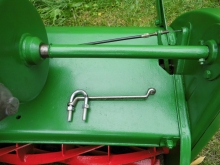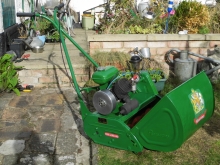Ransomes Marquius Sloper engined... Hand clutch
Hi,
I had the misfortune to suffer a broken clutch cable at the end of last year, and thought. That can't be too hard a job to sort.
I am new on here, but used to working on mechanical things (usually classic cars)
I didn't work out how to adjust the chains in a way that I was happy with so I've reassembled it and put do not use on it, until I am happy with it!
One thing I did notice that was definitely wrong was there appears to be a missing small spring. It looks like it should give a bit of resistance to the lever.
The spring is behind the clutch plate nut and runs down the centre on a pin with a large head. There is also a ball bearing.
I am assuming that the should be a spring, because this just flops around as it is and doesn't achieve anything, and it looks sort of related to gearbox parts I have worked on in the past.
Can someone let me know how this should work, if there is a spring and if there is, where I can find one that will do the job?
Thanks,
Jason Farmer
Forums
Thanks, I can understand that
Thanks, I can understand that,
I 'll have to check again, as I only remember seeing the mushroom headed pin, and the ball bearing, The short pin didn't seem to be there... but like I say I'll check before commiting.
I'll have another play at getting the chain tensions right, they were ok before I removed them, I confess I didn't mark positions as I wasn't expecting the freedom of movement that there actually is!
Thanks for your help
If the clutch was working ok
If the clutch was working ok before the cable broke the chances are that the missing pin "escaped un-noticed" when you fitted the new cable, Time for a hands and knees search of the area where you were working.
Just to add to Hortimec's instructions for reassembling and adjusting the clutch. There's a small hex head adjusting screw with a lock nut at the lower end of the clutch cable fulcrum and lever. This is usually seized up and is best freed off while the clutch is apart and out of the chassis so that you can get at it without rounding off the hex. Once free and reassembled it can then be adjusted if necessary.
Adjusting the chain tension without dismantling requires a "peg spanner" of the correct dimensions either bought - still available) or home made.
Ransomes LCG1491 clutch adjusting tool
I made a peg spanner by using
I made a peg spanner by using a "U" bolt (as on car exhaust) 30mm between centres. This had threads fractionally over 7mm or 1/4" dia. which needed filing down a tad and by slightly rounding the ends it helps locating in the holes. I found that by slipping a ring spanner onto one leg this could be used to lever against the other leg.
I will try attaching a pic (my first try, so may not work). Happy chain adjusting.
Ken
My Pics did not attach first
My Pics did not attach first time, so trying again. The mower is Ransomes Minor Mk7, 18".



I take it the 'clutch plate
I take it the 'clutch plate nut' you are referring to is the round one with a couple of holes in it that lives behind the outer clutch pressure plate. If this is the case and the pin with the large head is the thing that pushes on the outer clutch plate and goes down the hole in the center of the thing that the 'clutch plate nut' screws onto, then there should not be a spring, there should be a short pin, a ball bearing and then the mushroom headed pin (the pin with the large head). When you operate the clutch lever on the handle, it translates the movement down to the clutch lever next to the rear roller, this either pushes the short pin, ball bearing and mushroom headed pin to release the clutch, or it takes the pressure off the pin etc allowing the clutch to drive the rear roller.
To adjust the chains, it is easier if you don't have the outer clutch plate fitted, but is possible with the clutch fully assembled. First make sure the cylinder to bottom blade adjustment is correct, altering this afterwards will affect the cutter chain tension. You then slacken the clutch center nut just enough to allow the clutch to move, now move the clutch about to tension the chains until you get the best balance possible, if one of the chains is a lot tighter than the other, then you may need to replace one. Once you have got the best possible chain tension, fully tighten the center nut and rebuild the clutch
Hope this helps you to understand how the clutch works, if not, just ask.